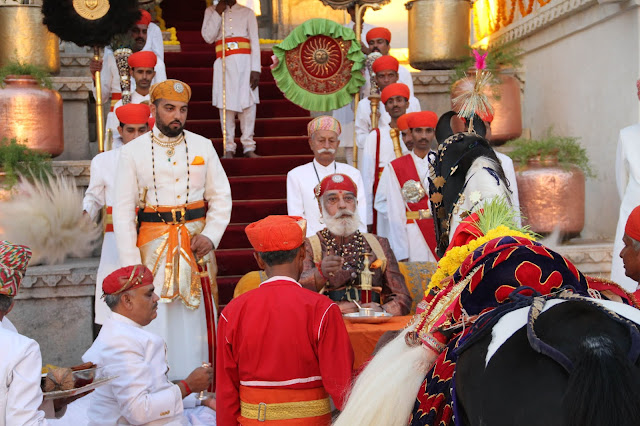The spirit of Navratri, Dusherra and Khejri Poojan overwhelms Mewar
The autumn Navratri (nine sacred days and nights) form one of the auspicious times in the Hindu calendar. On the ninth day of Navratri, which is a symbolic day of victory, arms and other symbols of the warrior are worshipped in northern India. In Rajasthan, famous for its cavalry charges, this day is also marked by the worship of war animals like the elephant and the horse. The worship of the horse, Ashwa Poojan, continues till date. The horses that are part of the rituals are those belonging to the 'Marwari' breed, a distinct internationally recognized breed that is threatened with extinction. MMCF and Shriji Arvind Singh Mewar of Udaipur, has set up the Equine Institute Udaipur to maintain a viable population of this culturally important animal. They are fully bred and nurtured by Maharana of Mewar Charitable Foundation, Udaipur. In the earlier tradition of Mewar, Maharana used to perform Gaj (Elephant) worship too with Vedic hymns after Ashwa Poojan sitting at Nagina Badi. After that, Maharana used to bid farewell to those present Sardar-Umrao (Nobles) and leave to carry out other religious works.
 |
| Maharana Sangram Singh II attending the Khejari Puja on DusherraAdd caption |
The celebrations of Vijaidashmi on Ashvin Shukla Dashmi have many royal Mewar traditions attached to it. One of them used to be Ahida ki Shikar, the first hunting expedition in the new hunting season after the rains; to go on important expeditions and to form a strong bond between the Maharana and the nobles, for which a feast used to be organized in the Palace. On this day, the Maharana would dress in white attire, wearing the Amar Shahi pag and worship Shree Pitambaraiji and Shree Nagnechia Mataji.
After that, the Maharana would mount his horse from the Pagda ki Hatni in Manek Chowk and go with full Insignias of the state, with entourage of nobles via Hathi Pol for Khejri Poojan, in now days Madhuban, where there is still a vacant plot there. The place would be in a temporary enclosure with a gate installed at the front; the Maharana would touch the top of the gate symbolically with his sword and before entering the enclosure to commence the Khejri Poojan.
Before India’s independence on this occasion 100 or 150 guns-salutes were given, but after the merger of Mewar state into the Union of India, the gun-salutes were reduced to 21. On this occasion worshiping of the arrows with recitation of Vedic hymns was performed and they were sent through messengers to the all gate of the City to announce that the Maharana as per the auspicious time is now ready to move in any four direction for pilgrimage or any other travel.
Later the Bards would recite the traditional eulogy in presence of the Maharanas in the court for which they were given some reward. Before the court was dispersed, the Maharana would distribute betel bidas to nobles, indicating that they could now leave. The Maharana would mount his royal elephant and return to the Palace. On this occasion, a court was also held at Nahron ka Darikhana inside the Palace in Manek Chowk.
Mewar has been a devotee of various forms of Goddess Durga, also known as ‘Shakti Peeth’ from times immemorial. The House of Mewar has often made generous contributions to construct, strengthen, renovate and maintain many small temples, ‘devras’ and other places of worship of Goddess Durga. Most of these temples are owned and managed by Shree Eklingji Trust. Presently the maintenance of these temples and facilities for the devotees is being administered and performed by the Chairman and Managing Trustee of Shree Eklingji Trust, Shriji Arvind Singh Mewar of Udaipur.7. Shree Asavra Mataji (Aavri Mata), Chittorgarh: Shree Asavara Mataji holds a prominent place among Mewar’s Shakti Peeths. Built before the 14th century, this temple is situated in Asavara village of Chittorgarh district. It bears a white stone idol of Asavara Mata, resembling the ‘Mahishasurmardini’ form. All pujas, rituals, yagnas etc. are conducted as per the ancient Vedic rules and regulations.
8. Shree Dashmukha Kalika Mataji, Shree Eklingnath ji Campus: Kalika Mata temple is one of the sub temples in the premises of Shree Eklingnathji temple. Shree Eklingji Trust sees to the upkeep of the temple and observes both the Navratras.
11. Shree Hast Mataji, Udaipur: Hast Mataji temple built by Maharana Karan Singh (r.1620-1628 CE) is also included in the prime Shakti Peeths of Mewar. On the seventh day of each Navratra, the Maharana would worship at this temple and sacrifice of two male goats in the name of Mataji was done.





Comments
Post a Comment